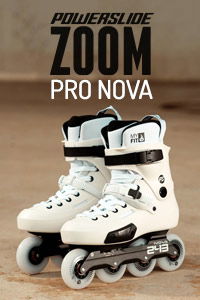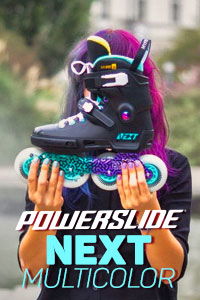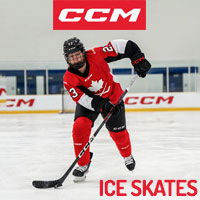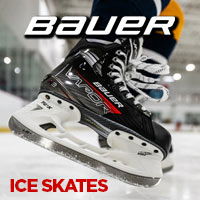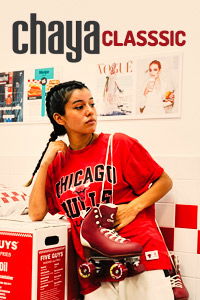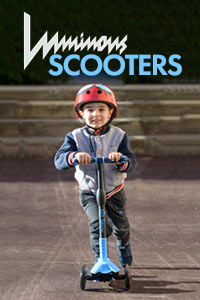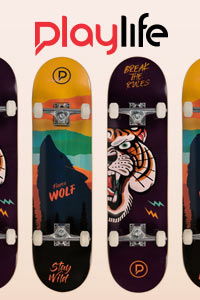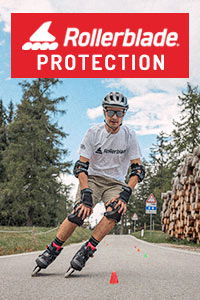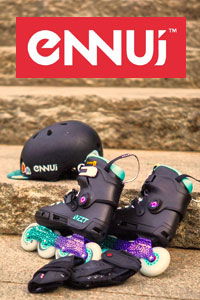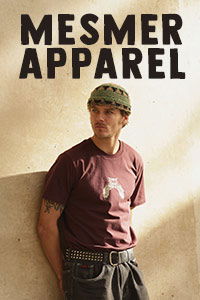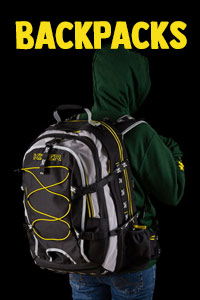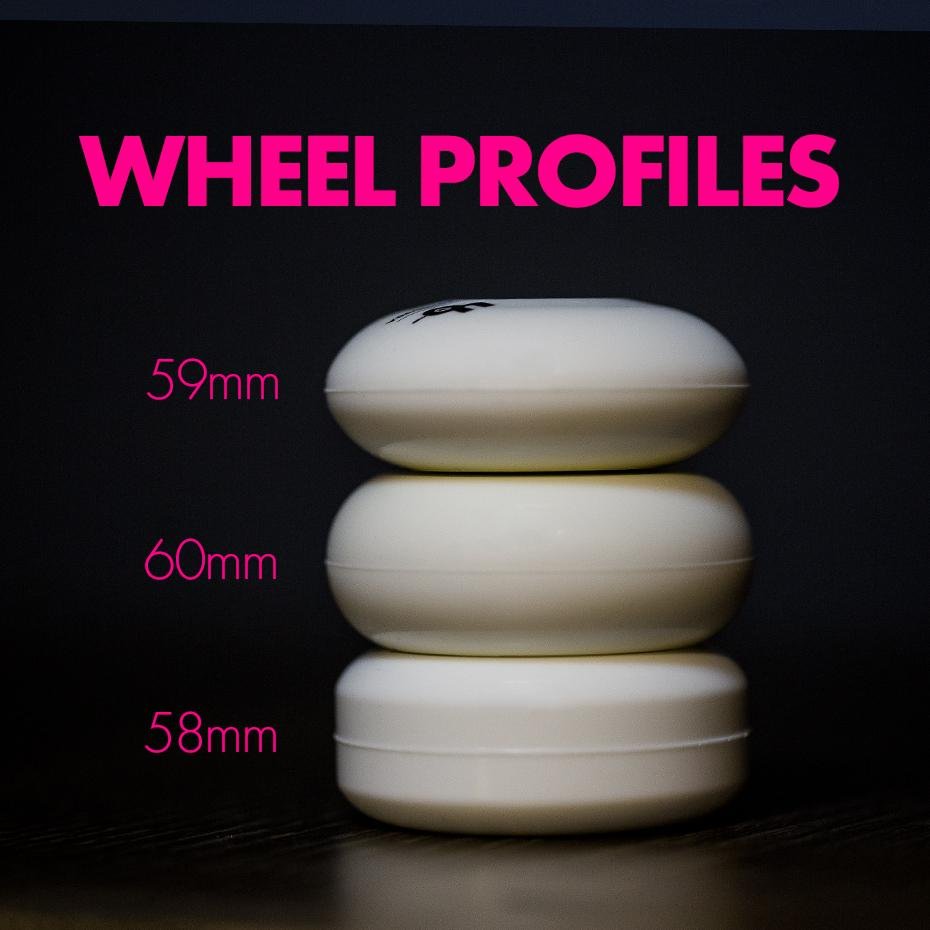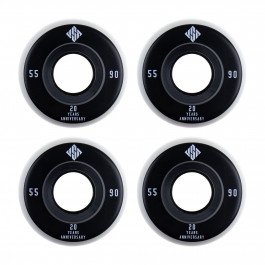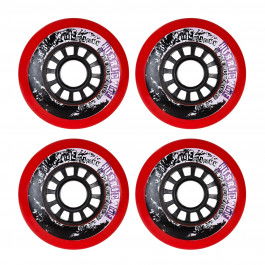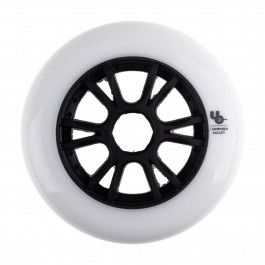No all wheels are created equally
If we were to point out a single most important part when it comes to how skating experience feels, we would, without a shadow of doubt, choose wheels. It’s up to them how smoothly (or not) we roll and how setup handles during turns and other manoeuvers – that’s why it’s worth to give some more thought regarding wheels choice.
We have already covered a subject of wheel hardness in separate article. Apart from hardness, other important factors when it comes to choice of wheels are core, rebound and profile. In this piece we’ll take a closer look at profile, as it greatly shapes how skates handle.
Wheel profiles
Let’s start with a brief explanation what actually is a wheel profile. To put it simply, it’s a shape of wheel urethane cross-section. We can group wheel profiles in to three broader categories, as you can see in the photo below: flat, round and bullet.

Flat profile
These wheels are the rarest and used almost exclusively in aggressive skating. Usually, flat profile wheels are used in frames designed for antirocker or freestyle setups - ones in which only two wheels touch the ground.
As weight is distributed between only two wheels, each one of them wears faster than in case of three or four contact points. Flat profile wheels have the most urethane on them and their contact area is the widest - this makes them more resistant to wear than slimmer alternatives.
Flat profile wheels give a good stability of ride and landings. However, because wheel edges are nearly a 90 degree angle, turning is severely impacted. Moreover, the wheel can lose grip on really sharp turns, which may result in slip-outs and falls. If flat profile wheels are used in flat aggressive frame, four down, the risk of wheel bite during grinds on frame groove is really high. Wide urethane leaves little space for error and you must go really low on tricks to not catch the ledge with middle wheels.
Last thing worth noting, is wheel footprint. In case of flat profile wheels, footprint is the largest – and bigger the footprint, the more rolling resistance it has, which results in slower wheel. In fact, flat profile wheels are the slowest out of all three types and skating on them can feel tiring and cumbersome, especially when they are used in antirocker/freestyle setups, which further limit manoeuvrability and give worse rolling. You can see wheels footprints on earlier photo, marked with pink lines
We recommend flat profile for: aggressive skating with emphasis put on grinding obstacles – especially for budget oriented skaters who look for long lasting wheels for their antirocker and freestyle frames. It’s a perfect wheel type for sessions on spots like ledges and rails, where actual skating is limited to rolling up to and from an obstacle.
Round profile
In theory, it’s the most universal solution – a middle point between flat and bullet profiles. In practice, it is far from being the most popular option. Usual applications of such wheels are urban skating, freeskating and aggressive with flat (four wheels in frame touching the ground) setups. Sometimes, round profile wheels are used in skates made for kids.
Round profile delivers good stability on landings and while rolling, coupling these qualities with decent ability to turn. The amount of urethane on wheel is still rather generous, which makes these wheels long lasting. Considering these characteristics, it’s no surprise that many fans of urban skating and aggressive choose round profile wheels.
Thanks to wheel footprint being largely the same no matter at which angle it touches the ground, you can go low on turns without noticeable change in grip. This makes skates behaviour more predictable – there is no almost hard angle like in case of flat profile wheels or narrow edge like in wheels with bullet profile. On the other hand, because lack of that edge, it’s harder to make round profile wheels slide. Take a look at photo below to see for yourself:

Round profile also limits the risk of wheel bite in flat aggressive frames. It also makes skates more agile and not only in case of flat – with antirocker and freestyle setups, where it allows for taking corners easier while still maintaining a sensible resistance to wear.
Contact surface with the ground is halfway there between flat profile and bullet one, which allows for a fairly decent amount of speed thanks to manageable rolling resistance. Round profile wheels are not considered fast, though, and as such are not used in speedskating and speed slalom for example.
We recommend round profile for: every skater who is on the hunt for universal, reliable and long lasting wheels to be used in urban skating and aggressive (flat setup). It’s great choice for skaters who don’t care about speed as much as about smooth rolling, stability and slow wear. Beginners can use round profile wheels as training tool if stock, bullet profile wheels seem to make skates a bit too hard to tame due to their speed.
Bullet profile (elliptical profile, speed profile)
It is, by far, the most popular wheel type in skating – absolute king. Such wheels are used in speedskating, fitness, urban skating, freeskating, slides, freestyle slalom and inline hockey. Recently, companies started to make bullet profile aggressive wheels and they too have found their audience.
Why bullet profile wheels dominate the market? First of all, they are the most dynamic wheel type. Not only their speed is outstanding when compared to other two variants, but also ability to turn which they provide is above the average. This boils down to the fact that only a narrow patch of urethane makes contact with the ground at any time, giving minimal rolling resistance. However, if you’ll go really low and make a sharp angle between wheel and the ground, the contact surface will actually be bigger. Between these two points, there’s an area (edge) where grip is very limited, which make slides possible.
All of this has downsides when it comes to landings – if you’ll make a bad landing, it’s easy to slip off and lose balance, resulting in fall.
Bullet profile wheels wear the fastest. Moreover, over time they lose their slim profile and even with rotating wheels in frames regularly they ultimately end up looking very similar to round profile wheels. That’s why in disciplines where speed and precision matter, like speedskating and freestyle slalom, skaters do not compete on wheels with visible wear, as those behave differently to new ones and can impact skater’s performance in negative way.
In aggressive skating, bullet profile wheels are used almost only in flat setup frames due to relatively quick wear which can be minimised by distributing weight on four wheels per skate instead of two. Like in other skate types, bullet profile wheels make ride more dynamic – faster and with easier turns. A huge advantage for grinds is geometry of these wheels – out of all three profile types, they are least likely to give you wheel bite.
We recommend bullet profile wheels for: skating, where speed matters. For dynamic urban skating, freeskating, slides. Where agility matters, like in freestyle slalom and inline hockey. For skating flat setups in aggressive to gain more speed, agility and minimise risk of wheel bite on ledges and rails.
What else you should know.
Wheel profiles, even though they can be divided in to major three types, differ between manufacturers. You can find bullet profile wheels in which semi-major axis of ellipse is shorter or longer, resulting in narrower or wider contact surface. There are wheels on the market in which profile is halfway there between flat and round. Cheaper wheels often have asymmetrical profile – a measure to save on material and production costs.
Keep in mind that profile is only one of characteristics of given wheel and it doesn’t influence ride alone. A soft bullet profile wheel can be slower than harder round profile one. Landings on bullet profile wheels of 59mm diameter will be more stable that on 80mm round profile wheels thanks to lower centre of gravity.
Different profiles behave differently on various surfaces! On rough surfaces, like pavements made out of sett stones, old, rugged and/or cracekd asphalt, the wider the profile, the smoother ride feels. Bullet profile wheels may even lock in between pavement tiles. There's a simple rule here - the narrower the profile, the worse it copes with rough surfaces (keeping the wheel diameter unchanged, of course). This is especially important for aggressive skating, in which wheels are small and have worse roll by pure physics. Always keep in mind condition of spots you skate when choosing the wheel. For freeskating/urban skating it may be better idea to go for round profile wheels if you live in a city which remembers medieval times in places.
Moreover, wheels always lose profile over time! No matter how often you rotate them (which is recommended to improve longevity and skating experience), your skating style will take its toll on the wheels and change their shape in unique way. A lot depends on technique and what discipline you practice. Some skaters wear their wheels to be almost completely flat, others in to a profile of a sharp cone.
In the end – you won’t know if a certain type of wheels is best for you until you try them. Especially in aggressive and urban skating, it is worth to give a chance to different profile than you are used to.


